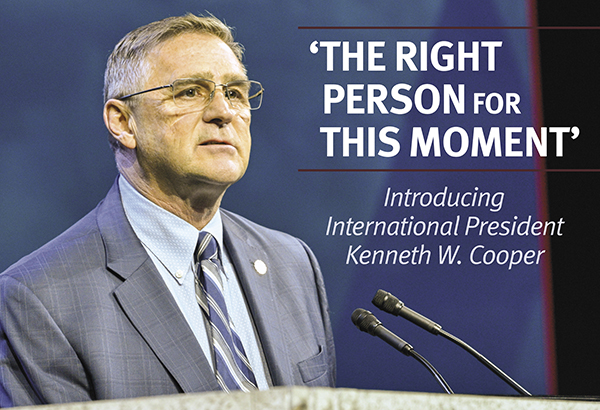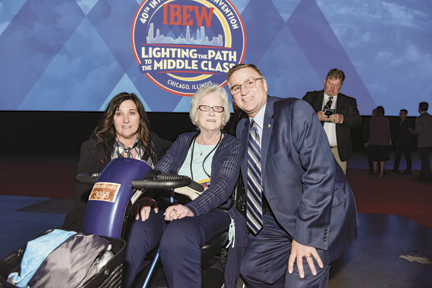
https://ibewhourpower.com/category/presidents-message/
Kenneth W. Cooper grew up in a house with no indoor plumbing in one of the poorest neighborhoods of a dying Rust Belt town and then joined one of the smallest construction locals in Ohio.
On Jan. 4, he took over as international president of one of the most powerful labor unions in North America.
“Every brother and sister in the IBEW knows there are no self-made men in a labor union. I joined the IBEW because I wanted to provide for my family the life, stability and opportunity I didn’t have as a boy,” Cooper said.
Cooper was chosen after six years as international secretary-treasurer and nearly four decades in the IBEW, rising steadily through the ranks since his election as business manager of Mansfield, Ohio, Local 688 when he was only 31 years old.
“The IBEW is at an extraordinary moment, and Coop is the right person for this moment,” said retiring International President Lonnie R. Stephenson. “Decades of work rebuilding our ranks has opened unprecedented opportunities over the next two decades. He’s a listener, a uniter and, when the time is right, decisive.”

After his appointment, Cooper thanked Stephenson and the International Executive Council for their faith in him.
“When Lonnie was appointed, we were still clawing our way out from the Great Recession. We faced the most anti-union U.S. government in decades, and we had to weather a global pandemic. But because of Lonnie, we have grown nearly every year, built a relationship with a sitting president that is unique in American history and delivered political victories that set this union up for decades of growth,” Cooper said. “Lonnie set the highest possible standard as a leader, a man and as a friend.”
Cooper will fill the remaining four years of Stephenson’s term. Cooper was replaced as international secretary-treasurer by Sixth District International Vice President Paul Noble.
Kenneth W. Cooper, then Fourth District international vice president,
signs the certification of the winning election at Baltimore Gas & Electric in 2017.
Welcoming the more than 1,400 BGE workers into the IBEW was one
of Cooper’s proudest moments leading the district.
Little Kentucky
Mansfield lies smack between Ohio’s two largest cities, Columbus and Cleveland. At first it was a farming town, almost a village. When three rail lines chose Mansfield for a crossroads, it grew into a small industrial powerhouse.
By the turn of the 20th century, Mansfield was home to dozens of union foundries and factories with a steel mill at its heart.
At its zenith, Mansfield was home to more than 50,000 people — nearly half the voting population were members of the trade council — and its economy was so strong, the local story went, that the Great Depression almost passed it by.
Ohio became a particular draw for families like Cooper’s living several hours south in Kentucky, where the Great Depression was felt to the bone. Throughout the 1930s, dozens of families made the trip north to Mansfield, cousin joining cousin in a settlement north of downtown eventually called Little Kentucky. It was close to the mill but far from municipal sewers, water or electricity.
“I think 90% of the houses were built from crates from stuff coming to the mill. People saved them and built houses out of them,” Cooper said.
Like all the houses near his on Belmont Street, Cooper’s had an outhouse in the back yard. The well his grandfather dug fed eight neighboring homes in addition to his own.
Cooper’s grandfather came to Little Kentucky to work at the mill and joined the Steelworkers. Until he became permanently disabled, Cooper’s father had been a United Auto Workers member.
That left Cooper’s mother the sole bread winner, a line worker in a nonunion factory that made kitchen supplies. A nonunion job leaves a family hard choices. Sometimes that choice was as basic as food or heat. She was far from the only one forced to work without a union wage or decent benefits in those years.
Those union factories handing out jobs in the ’50s died, left or shrank, first slowly in the ’60s and ’70s, then fast in the ’80s and ’90s.
“Mansfield didn’t die. It was murdered,” Cooper said. “Those factories didn’t move or shut by accident. Decisions got made far away to break the back of the unions and the pride of working families.”

(Pictured Left) Cooper celebrates at the 2022 International Convention with his wife, Gina, and mother, Donna, after his election to a full term as international secretary-treasurer.
IBEW: The Path Forward
The only way up was a trade that paid, and after high school, Cooper found work as a welder at Quanex, a 500-person union factory that supplied exhaust crossovers to Ford Motor Co. He joined the Steelworkers and even as a young man was a steward. He took night classes at Ohio State University for two years toward a business degree.
But it was still work that could be shipped away, and in 1984 he applied to two apprenticeships, the United Association (plumbers and pipefitters) and IBEW Local 688. He was accepted to both, probably because of his welding skills, Cooper said.
“I chose the IBEW because you would have a better education as an electrician than a plumber and a fitter. That’s just how I felt: Electricity was a bigger challenge, and I wanted a challenge,” he said.
Work was so scarce that, even though he joined the apprenticeship four years before Cooper, Carl Neutzling, now the business manager of Local 688, topped out at about the same time.
Neutzling said he and Cooper worked together fairly often in those years, and while Cooper was known for his sense of humor and his good company, he also earned a reputation for a relentless work ethic and devotion to the IBEW.
Cooper topped out in 1989, and within a year he was vice president. When the sitting president left for a job at OSHA in 1992, Cooper was appointed to fill the vacancy.
A year later, Cooper won a four-way election, becoming one of the youngest business managers in local history.
“Kenny has a way of listening to everybody before saying the right thing to the right person at the right time,” Neutzling said.
Organizing Victories
Cooper said he quickly realized that whatever problem you had, it was nearly always made better, if not solved, by increasing numbers.
In 1994, Cooper led the largest organizing victory in local history when he signed Neer Manufacturing’s 175 workers, increasing local membership to more than 700 members, the largest the local has ever been.
“He was so adamant about organizing,” J.R. Rice, then the organizer at Local 688 and later its business manager, said of the Neer campaign. “Kenny’s will to make this happen was extraordinary.”
Cooper also oversaw the largest construction project in local history when a continuous thin caster was installed at the mill. For more than a year in the mid-’90s, more than 250 travelers were in his jurisdiction.
“We had as many travelers as we did local hands, and when I went to the membership, I said, ‘Pretend that the caster doesn’t even exist; do we have full employment?'” Cooper said. “When we asked how we can handle a job bigger than the local union and still manage the local union, there was that same answer: growth. It’s always the answer.”
Cooper was reelected three times, and then in 2002, he moved west to Las Vegas with his wife, Gina Cooper — now the Fourth District international vice president. He was hired as an assistant business manager at Las Vegas Local 396 and put in charge of the relationship with NV Power, the local utility. Cooper, relentless in the belief that organizing makes us stronger, organized five more units at the utility. Later, when the local was given the outside jurisdiction, he was put in charge of that and led the successful effort to sign Davey Tree.
By the mid-2000s, Cooper had caught the attention of International President Edwin D. Hill, who called him back to the Fourth District and appointed him an international representative.
International Leadership
Cooper moved to western Maryland and in his first year was the service rep for telephone locals in Ohio, then from 2007 to 2011, he primarily serviced utility locals from West Virginia to the Eastern Shore of Maryland.
In 2011, when Fourth District International Vice President Salvatore “Sam” Chilia was appointed international secretary-treasurer, Hill called on Cooper again, this time to replace Chilia.
Cooper wrote a 100-day plan to set the targets and the tone of his tenure. He also required all new business managers in the Fourth to have one.
“A 100-day plan is about organizing and relationships — you have to have both of those to be successful,” he said.
In his 100-day plan, Cooper said, he arrived at his three highest priorities: Baltimore Gas and Electric, the largest nonunion utility in the Fourth District, which had voted four times against joining the IBEW; organizing Asplundh Tree’s dozens of units across more than five states; and expanding the use of regional agreements covering the projects smaller than 200,000 square feet that many signatory contractors had stopped bidding.
In the next six years, Cooper oversaw the massive blitz at BGE involving organizers from across the country over more than two years that finally brought 1,400 new members into the fold. He led the team of organizers that won 39 of 42 elections at Asplundh Tree. And by 2017, the number of contractors who signed on to small works regional agreements grew from 11 to 455 — the smallest scope, for projects under 15,000 square feet, was the most commonly used.
He began tracking the work hours on the small works program and found the agreements not only increased hours for construction electricians and construction wiremen but also significantly increased the hours for apprentices and journeymen. He used this information to help him gain the support of all the Fourth District local unions for these agreements.
In 2017, Chilia announced his retirement as international secretary-treasurer. Stephenson asked Cooper to fill the remainder of Chilia’s term. Cooper was now the ultimate trustee for the billions of dollars paid by hundreds of thousands of IBEW members for their health care and pension funds, the benefits that are a firewall between a middle-class life and a life where choices are made between food and heat.
In his five years in charge, Cooper and his team revamped the investment strategy to include infrastructure investments and requiring labor standard provisions for all projects that used IBEW funding.
Under his leadership, the IBEW’s two pension funds, the NEBF and the NEAP, posted strong asset growth, and the Family Medical Care Plan went from $500 million in assets to more than $750 million.
The IBEW’s Future
Cooper begins his presidency with a good problem to have. The industries at the core of the IBEW are set to expand by hundreds of billions of dollars in the next two decades. In addition to the regular work of construction and building, maintaining and upgrading the grid, entirely new industries are growing: solar, offshore wind, electric vehicles and battery storage, just to name the largest.
To maintain market share, Cooper said, the IBEW will have to grow significantly, back to the membership it had when it was at its largest in the ’70s: 1 million members.
Cooper said he thinks back to the time when he had as many travelers as local hands in his jurisdiction, and he now sees the entire IBEW as in a similar place as Local 688 was back then. “The difference is that we will not be able to traveler our way out of this situation or apprentice our way out,” Cooper said. “We must organize the unorganized if we are going to gain market share.”
“We have this opportunity only because of decades of work by our predecessors. How will we come out the other side? Stronger than we ever have been? Larger than we ever have been? Closer to our original purpose of organizing the entire electrical sector?” he said. “We owe it to one another as members, to future members, and to our communities to answer those questions. And that is my highest priority.”
Thankfully, he said, those are questions we can only answer together.



